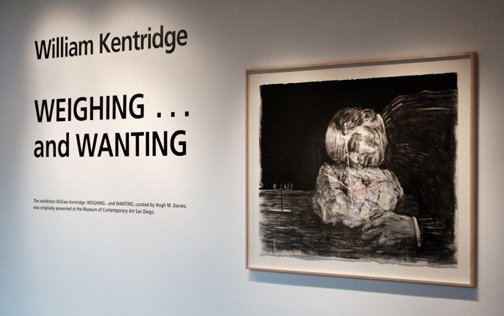
"Weighing and Wanting" Installation Shot Hoffman Gallery
Despite the discouragement of the weather and the natural predilection for hibernation during this time of the year, there is soulful reason this month to bundle up and get out. Lewis and Clark's Hoffman Gallery is currently exhibiting "Weighing and Wanting" an animated film and associated drawings by William Kentridge. Kentridge is a world renowned South African artist lauded for his simple but poignant allegories. Executed entirely in charcoal and bits of red and blue pastel, Kentridge's works literally and figuratively explore the human elements of strife within torn, dichotomous landscapes. His pieces move in circles, chronicling the inner workings, struggles, and questions of a created protagonist. These melodic sets become the framework for each protagonist's introspection and the architecture of the artist's voice.
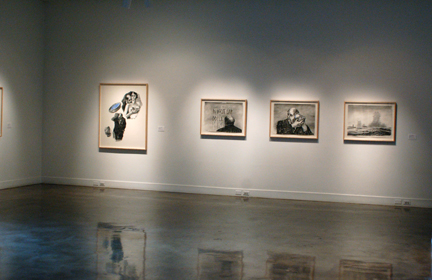
"Weighing and Wanting" Installation Shot Hoffman Gallery 2007
Upon entering the gallery, the weight and profundity of these works is immediately tangible and silencing. They hush. Comparable to entering a gothic cathedral, their presence elevates. There is something of the old world in them that grants them a timelessness. They are rife with a purpose detached and unconcerned with the art world or market. Charcoal is not the latest medium. These days it is relegated mostly to the education of figurative technique among students. Yet Kentridge depends on its malleability and emotive qualities to entirely build his oeuvre. He wields the soft bits as maestro unconcerned, and the connotations one might make with his chosen medium do not surface. This is the sign of extraordinary work, work that stands apart from the masses. There are so many charcoal drawings in the world. There are so many photographs, so many images in general, and yet, Kentridge's work is magic. It lulls to intrigue and captivates. To dissect it would be good like exercise is good, but to actually pinpoint this magic is an elusive thing. A far more skilled writer would be in order. All rhetoric surrounding Kentridge's drawings and films do not really nestle into what sets him apart; they merely skate around it, yearning to get at it and mostly failing.
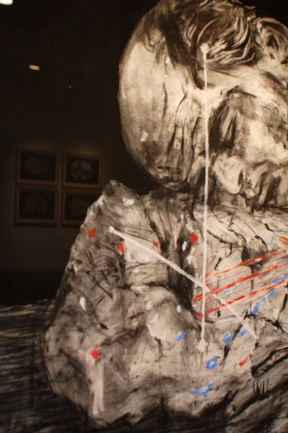
From "Weighing and Wanting" Detail
"Weighing and Wanting" (1997) is the chronicle of created persona, Soho Eckstein, as he wrestles internally with the end of love. The film eludes to the bitter knob of betrayal and the amorphous paths of self doubt and suspicion. The rhythm of the images is mirrored by the instrumentation of the soundtrack as each move back and forth and fold in unto themselves. Kentridge's own set of symbols are the juiciest, most poetic bits: the spines of ladies becoming oil rigs amid the quiet consultation of coffee cups. As Kentridge seems to glean much of his material from the steps of South Africa's ruins, much of his reference reaches further into the golden gullet of the classics. At a pivotal point in the film , Eckstein sees the words, "In Whose Lap Do I Lie?" appearing before him on the wall. This line refers to the Shakespearean sexual innuendo used by Hamlet while flirting with Ophelia. The title of the piece itself, "Weighing and Wanting" is a reference to the biblical tale of King Belshazzar of Babylon. In this certain tale, a disembodied hand appears before him and writes a message on the wall: "You have been weighed in the balance and found wanting, for you have not humbled your heart before God, so your kingdom has come to an end." Kentridge intertwines the classics and the created subtly and seamlessly, resulting in a level of dynamic so rich that it's almost bloody.
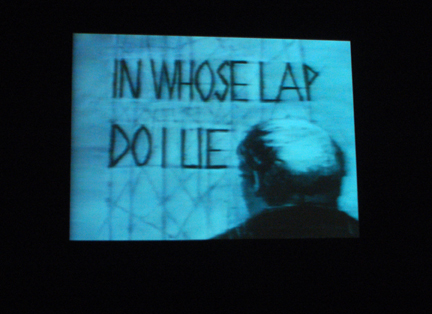
Still from the film "Weighing and Wanting" 1997
Kentridge's work travels around the world. The demand for his work posts it on YouTube to render it endlessly accessible. Yet, to see the actual drawings in the skin is extraordinary. They are thick with theater, nostalgia, and the light of drama; they recall the light and age of projection in their flickering and overexposure. The history of the drawings is visible and gives them the quality of film and movement even as still objects. They reminisce with the first silent films, with Wim Wenders' and his Wings of Desire, old war reels, and Max Beckman. They place the epicenter of an earthquake on the spine of a lover and the source of madness deep beneath the outer layers of symbolic sedimentary boulders. To miss this show would be a loss not easily overcome; it is an exhibition of profound beauty and an accounted, palpable depth.
Through Sunday December 16th at Lewis and Clark College's Hoffman Gallery
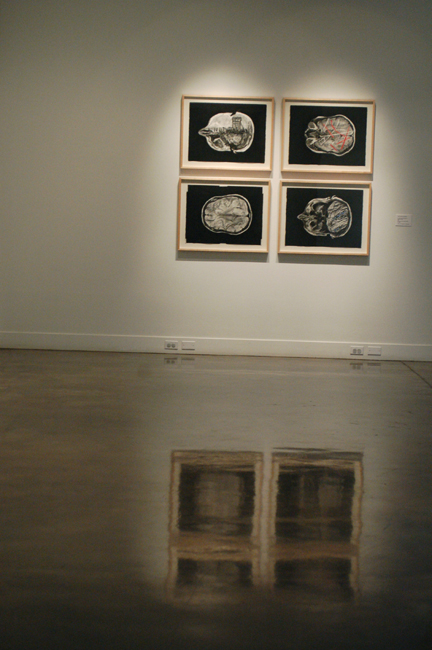
Thanks for signing in,
. Now you can comment. (sign
out)
(If you haven't left a comment here before, you may need to be approved by
the site owner before your comment will appear. Until then, it won't appear
on the entry. Thanks for waiting.)






















